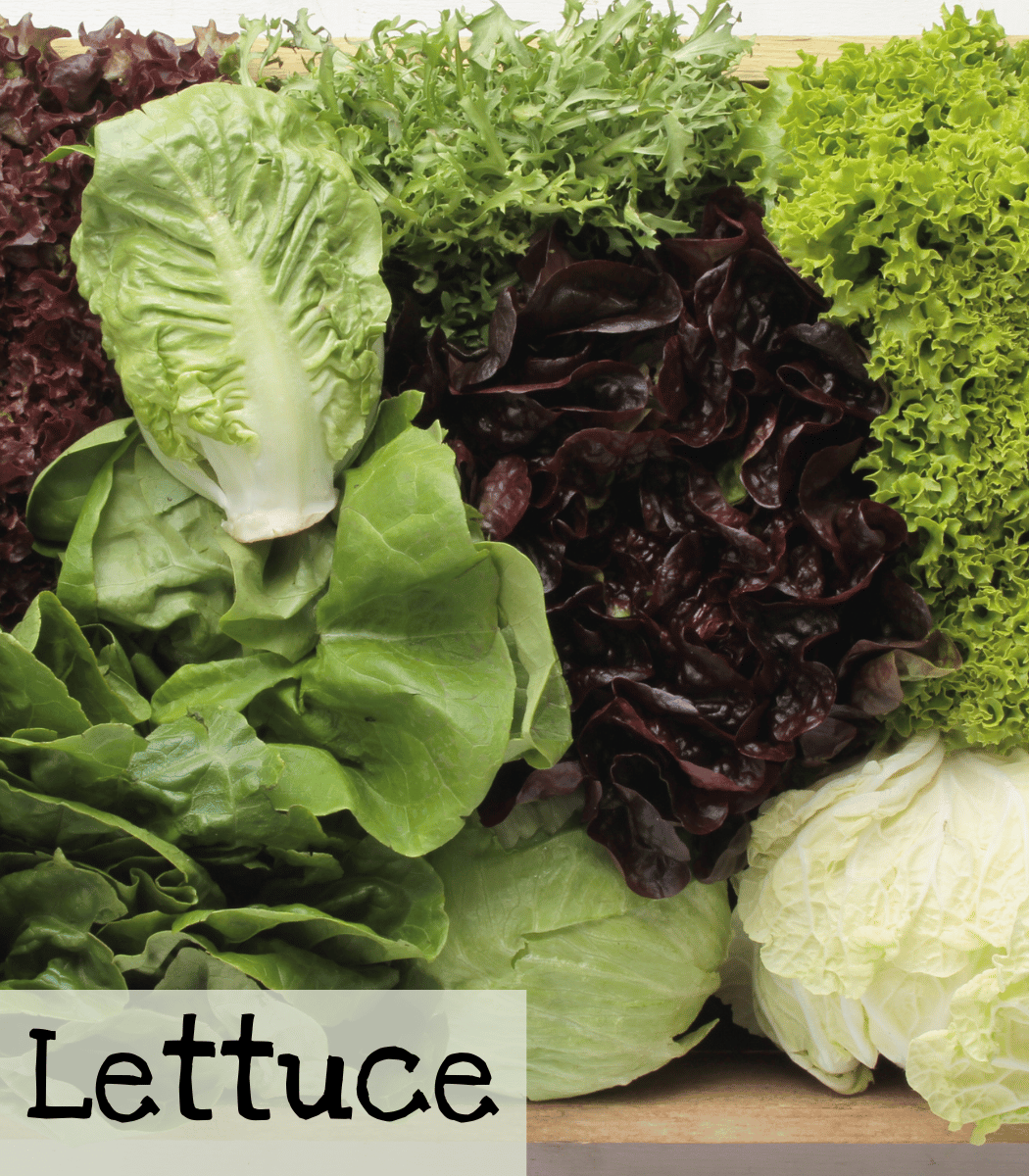
Lettuce
Often used as a base for salads, lettuce can also be roasted. This cool weather crop is filled with vitamins. Varieties come in different textures and colors, adding culinary beauty to many dishes!
|
Head Lettuce: Landis Winter Loose Leaf: Black Seeded Simpson; Gourmet Blend Mesclun: Mesclun Classic Mix; Mesclun Provencal; Mesclun Spicy; Mesclun Sweet Salad Mix Romain: Crisp Mint; Little Gem; Spotted Aleppo Syrian; Yedikule |
|
Lactuca sativa |
|
Easy |
|
Intermediate |
|
3 years if properly stored |
|
Annual |
|
Requires light to germinate 7-20 days |
|
None |
|
Surface Sow |
|
Partial to full sun Needs light for germination |
|
Landis Winter is frost-hardy |
|
21-35 days–sweet 45-60 days–other varieties |
|
February and September |
|
Yes |

Growing Tips


ONLY Loose-leaf varieties and small-headed varieties like buttercrunch–12+” container
When to Start
Spring: Direct sow 2-4 weeks before the last frost. (Jan 14-Mar 1 for GA)
Fall: Direct sow 4-7 weeks before the first average frost. (Sep 1-Oct 1 for GA)
How to Start
Lettuce requires a growing temperature of 50-68 F and rich moisture-retentive soil. Transplanting is not recommended. It can be done it just is very tricky to do. The crown must be at the soil level. Too high or too low and the plant will probably die.
Direct sow 2-4 weeks before the last frost in spring or 4-7 weeks before the first frost in fall. Lettuce needs light for germination. Gently press into the soil or cover with a very light sprinkling of soil to keep the seeds from blowing away.
Thin loose leaf varieties to 4 inches and heading varieties to 8-12 inches.
Care
Row covers can be used to protect plants from any late freezes. They can be also used to extend the growing season in fall or allow you to plant sooner in spring.
With the relatively short springs, Georgia growers might have better luck growing lettuce in the fall versus the spring as warmer temperatures will cause the lettuce to bolt and turn bitter. Afternoon shade can also help in areas with shorter springs.
Care is minimal. Keep the soil moist, but not soggy. Mulch can be used to suppress weeds and help the soil retain moisture.
For containers, consider using water bottle reservoirs to keep the soil moist between waterings.
Harvest
Harvest loose-leaf varieties by cutting the outer leaves. Harvest head lettuce varieties when they reach their mature size by cutting the head from the stock at the soil level or pulling the entire plant.
Pest Management
Slugs can decimate lettuce. Use slug traps to help control the slug population. The link is below.
Pro Tip!
Incompatibles: Not recommended to plant next to barley, wheat, and rye
Grows well with: Beet, all brassicas (kale, broccoli, etc.), carrot, cucumber, onions, lima beans
My personal experience
If find lettuce at little challenging in GA. I’ve tried spring planting and it just never seems to go well. The best lettuce I’ve ever grown (outdoors) was in the fall. It did what it was supposd to do! And it tasted fabulus! I wish I had a picture to show you. I’ve also experimented with growing lettuce indoors. This works really well and I can have fresh salad in the dead of winter. I do recommend growing it indoors in winter when the pests are dormant. When I grew it indoors in spring/summer, I ended up with aphids in the house! See my Growing Lettuce Year-Round for more details.
Seed Saving

Isolation Distance
Lettuce is self-pollinating, but plants can cross under some circumstances. Twenty-five feet of separation is generally sufficient to prevent crossing.
Instructions
Gather dried seed heads (they are easy to recognize) every couple or three days as they ripen and dry, or wait until most seed heads have dried and hang the plant upside down over a tarp or in a paper bag (harvest dry seeds if rains threaten).
Once pods or husks have been harvested, store them in a dry place and wait until they are thoroughly dry. When the pods or husks are dry enough they will easily crumble between your hands. Crumble the pods or husks until all the seeds are released.
Seeds and finer chaff are easy to separate by a variety of methods. One way is to use two screens of varying mesh, one a little smaller than the seeds and the other a little larger. The first screen lets anything smaller than the seeds fall through, and the second lets the seeds through and stops anything larger.
Features
Head Lettuce
- Landis Winter: A Bibb/Butterhead type. Heirloom. It is a very hardy, frost-resistant lettuce. Each head reaches 11 to 12 inches in diameter with a loose butterhead appearance.
Loose Leaf
- Black Seeded Simpson: Heirloom. Tender and delicately flavored leaf lettuce.
- Gourmet Blend: A tasty and colorful mix of five looseleafs in shades from green to red and textures from oakleaf to tightly ruffled. Fast-growing, tender, and colorful.
Mesclun
- Mesclun Classic Mix: Includes arugula, chervil, endive, mache, four lettuces (‘Oak Leaf’, ‘Prizeleaf’, ‘Red Salad Bowl’, ‘Green Ice’), radicchio, and upland cress.
- Provencal Mix: Assorted mixed greens that are traditional to the south of France. (chervil, arugula, lettuce, and endive)
- Mesclun Spicy Mix: A spicy mix of greens. (arugula, endive, red salad bowl, mustard, and radicchio)
- Mesclun Sweet Salad Mix: Includes heirloom varieties in red (‘Ruby’ lettuce, ‘Bulls Blood’ beet) and bright green (‘Bloomsdale’ spinach, ‘Simpson’ lettuce, ‘Tendergreen’ mustard).
Romaine
- Crisp Mint: Large, succulent, mint-green outer leaves with white hearts. Sweet and crunchy.
- Little Gem: Small romaine type. Good heat tolerance.
- Spotted Aleppo Syrian: Heirloom dating back to the 1600s. A romaine type that is often used as scoops for hummus and other purees.
- Yedikule: Heirloom. A Romain type that is known for its incredible flavor and tender, naturally oily leaves that need no dressing.

Transplanting is difficult. You need to get the crown at the soil level. Too low or too high will most likely kill the plant.
- Loose-leaf varieties: any time they are large enough to use. Harvest a few leaves at a time or cut below the crown to harvest the whole plant.
- Butterhead and iceberg varieties: Harvest when they have formed heads and the leaves are a good size.
- Cut below the crown to harvest the head.
